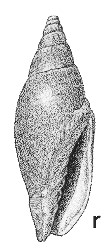
Revised descriptions of New Zealand Cenozoic Mollusca from Beu and Maxwell (1990)

 | Revised descriptions of New Zealand Cenozoic Mollusca from Beu and Maxwell (1990) | 
|
  (Pl. 21r): GS9500, J41/f8028, excavation for Oamaru Borough Council septic tank, South Oamaru, Altonian (GNS) |
Beu & Maxwell (1990): Chapter 11; p. 204; pl. 21 r.
Synonymy: Scaphella tumidior Finlay 1926b, p. 250; Waihaoia (Teremelon) tumidior; W. (Teremelon) awamoaensis Marwick 1926a, p. 280
Type species of Teremelon Marwick, 1926
Classification: Volutidae: Zidoninae
Description: Small for subfamily (height 33-48 mm), fusiform, spire 0.4 total height. Protoconch prominent, mamillate, of about 1.5 squat whorls, smooth or with weak spiral ridges. Teleoconch of 4.5-5 whorls, spire whorls gently convex, last whorl somewhat more inflated, elongate, only weakly excavated. Axial sculpture absent or confined to thin distant costellae on first 1 or 2 whorls. Spiral sculpture of very fine striae, and on some shells weak ridges as well. Shell otherwise smooth and polished. Aperture narrow, constricted posteriorly; anterior notch moderately deep, asymmetrical, fasciole weakly differentiated, not protruding. Columella oblique, almost straight, with 4 or 5 low plaits. Inner lip moderately callused posteriorly, but with only a thin glaze below. Outer lip thin, slightly indented near posterior end.
Comparison: As there seem to be no important differences between specimens of Teremelon from Trig Z, Otiake and Wharekuri on one hand, and those from the Altonian localities listed on the other, T. awamoaensis was regarded by Beu & Maxwell (1990) as a synonym of T. tumidior. Another Altonian species (T. cognata; Target Gully Shellbed) differs from T. tumidior in its larger size (height 55 mm) and its somewhat more prominent axial sculpture (persisting onto the third whorl), and in having a symmetrical anterior notch. T. elegantissima (Altonian, Weka Pass) is a much more slender and higher-spired species than either T. tumidior or T. cognata.
Species of Teremelon are smaller than most of the other New Zealand members of the subfamily Zidoninae, lack axial sculpture entirely or have it confined to the early whorls, have a moderately deep anterior notch, and have a weakly differentiated fasciole. The oldest known member of the genus (and the oldest New Zealand volute) is from the Red Bluff Tuff (Waipawan) of Pitt Island. (Paleopsephea neozelanica (Wangaloan, Boulder Hill) — formerly included in the Volutidae — was referred to the Turbinellidae by Beu & Maxwell 1990). The extant species "T". knoxi (Tongaporutuan-Recent), confined to the upper bathyal zone, has proved to be an Alcithoe species on the basis of molecular phylogeny, so offers little guide to the habitats of fossils, but at least some of the extinct species of Teremelon ranged into inner or mid-shelf waters.
Distribution: Duntroonian-Altonian; Otekaike Limestone, Trig Z, Otiake, Waitakian (type locality of S. tumidior); Mount Harris Formation, Awamoa Creek, Oamaru, Altonian (type locality of W. awamoaensis); Old Rifle Butts; Ardgowan Shellbed; excavation for Oamaru Borough Council septic tank, South Oamaru; Wharekuri Greensand, Wharekuri.
Cite this publication as: "A.G. Beu and J.I. Raine (2009). Revised
descriptions of New Zealand Cenozoic Mollusca from Beu and Maxwell (1990). GNS
Science miscellaneous series no. 27."
© GNS Science, 2009
ISBN
978-0-478-19705-1
ISSN 1177-2441
(Included with a PDF facsimile file
copy of New Zealand Geological Survey Paleontological Bulletin 58 in CD version
from: Publications Officer, GNS Science, P.O. Box 30368 Lower Hutt, New
Zealand)